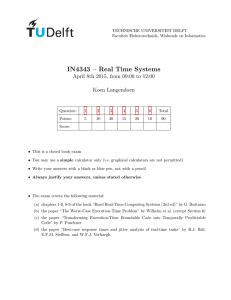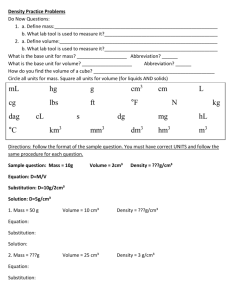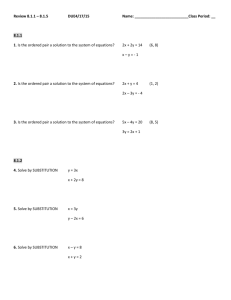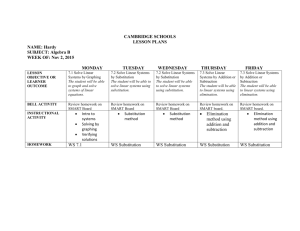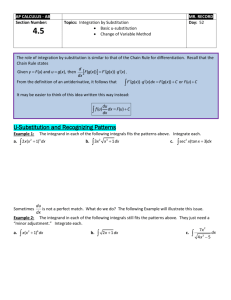NEWERAperiodic structures for pedestrians
advertisement
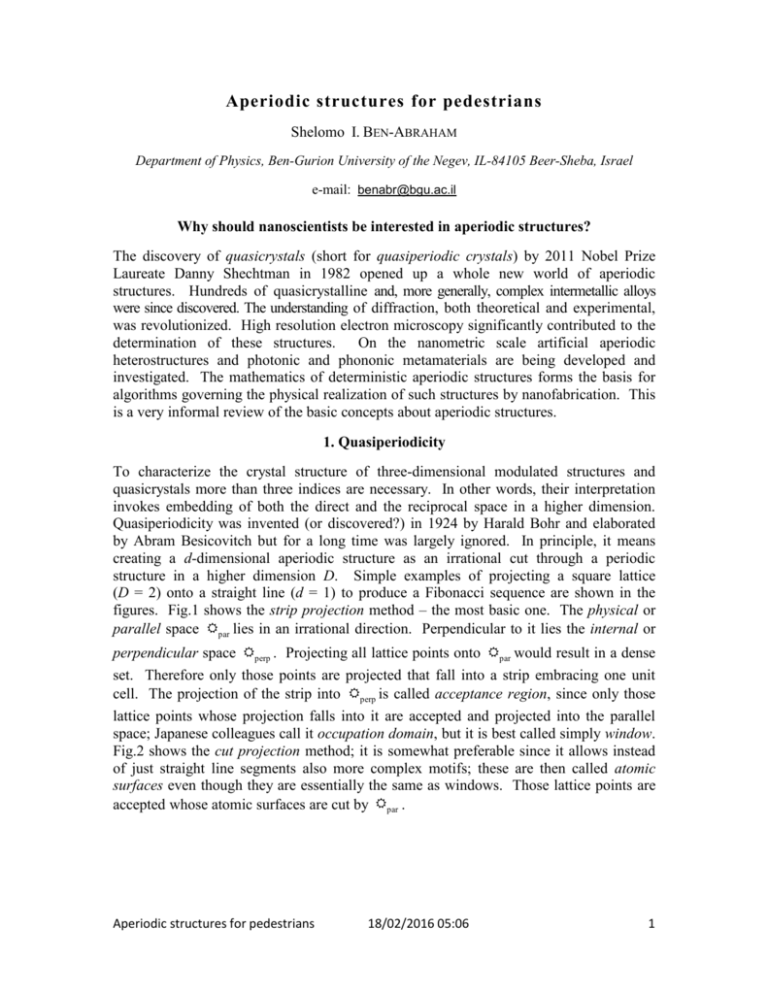
Aperiodic structures for pedestrians
Shelomo I. BEN-ABRAHAM
Department of Physics, Ben-Gurion University of the Negev, IL-84105 Beer-Sheba, Israel
e-mail: benabr@bgu.ac.il
Why should nanoscientists be interested in aperiodic structures?
The discovery of quasicrystals (short for quasiperiodic crystals) by 2011 Nobel Prize
Laureate Danny Shechtman in 1982 opened up a whole new world of aperiodic
structures. Hundreds of quasicrystalline and, more generally, complex intermetallic alloys
were since discovered. The understanding of diffraction, both theoretical and experimental,
was revolutionized. High resolution electron microscopy significantly contributed to the
determination of these structures. On the nanometric scale artificial aperiodic
heterostructures and photonic and phononic metamaterials are being developed and
investigated. The mathematics of deterministic aperiodic structures forms the basis for
algorithms governing the physical realization of such structures by nanofabrication. This
is a very informal review of the basic concepts about aperiodic structures.
1. Quasiperiodicity
To characterize the crystal structure of three-dimensional modulated structures and
quasicrystals more than three indices are necessary. In other words, their interpretation
invokes embedding of both the direct and the reciprocal space in a higher dimension.
Quasiperiodicity was invented (or discovered?) in 1924 by Harald Bohr and elaborated
by Abram Besicovitch but for a long time was largely ignored. In principle, it means
creating a d-dimensional aperiodic structure as an irrational cut through a periodic
structure in a higher dimension D. Simple examples of projecting a square lattice
(D = 2) onto a straight line (d = 1) to produce a Fibonacci sequence are shown in the
figures. Fig.1 shows the strip projection method – the most basic one. The physical or
parallel space par lies in an irrational direction. Perpendicular to it lies the internal or
perpendicular space perp . Projecting all lattice points onto par would result in a dense
set. Therefore only those points are projected that fall into a strip embracing one unit
cell. The projection of the strip into perp is called acceptance region, since only those
lattice points whose projection falls into it are accepted and projected into the parallel
space; Japanese colleagues call it occupation domain, but it is best called simply window.
Fig.2 shows the cut projection method; it is somewhat preferable since it allows instead
of just straight line segments also more complex motifs; these are then called atomic
surfaces even though they are essentially the same as windows. Those lattice points are
accepted whose atomic surfaces are cut by par .
Aperiodic structures for pedestrians
18/02/2016 05:06
1
Fig.1 – Strip projection method.
Fig.2 – Cut projection method.
Aperiodic structures for pedestrians
18/02/2016 05:06
2
2. Substitution systems
An important class of deterministic structures is provided by substitution rules on finite
alphabets. When referred to more than one dimension, the latter are usually called sets of
prototiles. Rather than quoting rigorous definitions, theorems and proofs let us see a few
simple instructive examples.
To start with, let us recall the Lebesgue decomposition of Fourier spectra. The Fourier
spectrum ̂ of a density measure has three disjoint parts:
ˆ ˆ pp ˆ ac ˆ sc ,
(L1)
where the subscripts stand for
pp = pure point, in physical terms Bragg peaks,
ac = absolutely continuous, essentially diffuse scattering,
sc = singular continuous, the exotic rest.
2.1. Fibonacci sequence
The Fibonacci sequence is the most popular and prototypical of all substitution systems.
It is defined on a two-letter alphabet A = {a, b} by the substitution rule
(F1)
a ab ,
ba.
Starting with b we obtain successively the chains
(F2)
b
a
ab
aba
abaab
abaababa
abaababaabaab
abaababaabaababaababa
………………………………….
We observe some interesting features. Except for the first entry, the chains start with a
and their ends alternate between a and b. The (n+1)-th chain is the concatenation of the
n-th and the (n1)-th chains. Hence the chain lengths satisfy the recursion relation
(F3)
F (n 1) F (n) F (n 1) ,
F (1) F (2) 1 .
This defines the sequence of Fibonacci numbers
(F4)
1,1,2,3,5,8,13,21,34,55,89,144, …
In the limit n the chains (F2) become the fixed point of the substitution, that is, the
infinite Fibonacci sequence.
Aperiodic structures for pedestrians
18/02/2016 05:06
3
The sequence of Fibonacci numbers can be extended to all integers:
(F5)
……
The ratios of two consecutive Fibonacci numbers approximate the golden mean and its
negative reciprocal 1 and eventually converge to them at positive and negative
infinity, respectively:
F (n 1) 1 5
1.618... ,
n
F ( n)
2
lim
(F6)
F (n 1) 1 5
0.618... .
n
F ( n)
2
1 lim
They are the solutions of the quadratic equation
x2 x 1 0 .
(F7)
The canonical realization of the Fibonacci sequence is as a tiling of the straight line by
segments L (for long) and S (for short) of relative lengths and 1. The sequence can be
extended to the entire line. As indicated in Sec.1 (on quasiperiodicity) the sequence can
be constructed by the cut-and-project method; thus it is manifestly double-sided. It is
even more important to note that there is an uncountable infinity of equivalent sequences
produced by shifting the cut across the window. Moreover, the sequence is quasiperiodic
with incommensurable periods and 1. Hence, its diffraction spectrum shows discrete
Bragg peaks, or more technically speaking, its Fourier spectrum is of the pure point type.
2.2. Prouhet-Thue-Morse sequence
The Prouhet-Thue-Morse sequence is perhaps the most intriguing among the standard
substitution sequences. It is defined on the two-letter alphabet A = {a, b} by the simple
and elegant substitution rule
a ab ,
b ba .
(PTM1)
Starting with a we obtain successively the chains
(PTM2)
a
ab
abba
abbabaab
abbabaabbaababba
abbabaabbaababbabaababbaabbabaab
…………………………………………………..
Aperiodic structures for pedestrians
18/02/2016 05:06
4
The length of the n-th chain (starting with 0) is 2n. Again, the chain ends alternate
between a and b. Somewhat surprisingly, the sequence is more complex than quasiperiodic. Its Fourier spectrum is of the singular continuous type.
2.3. Paperfolding sequence
The canonical paperfolding sequence arises by folding a sheet of paper repeatedly from
right to left and then unfolding it. The infinite sequence is, of course, an idealization,
since it is impossible to fold paper more than a few times (six or seven). Now label the
valley folds by a (or +) and the crests by b (or ) and the n-th chain by S(n). The
substitution rule is
S (0) a , S (n 1) S (n)aF ( S (n)) ,
(PF1)
F : S (a, b) S (b, a)
reverse and interchang e .
The successive chains become
a
aab
(PF2)
aabaabb
aabaabbaaabbabb
aabaabbaaabbabbaaabaabbbaabbabb
……………………………………………………
Here the pivot a (the first fold) is printed in bold type for clarity. The paperfolding
sequence is almost periodic (or limit quasiperiodic) and as such its Fourier spectrum is of
the pure point (Bragg) type.
2.4. Golay-Rudin-Shapiro sequence
The sequence named after Golay, Rudin and Shapiro (GRS) was independently
discovered (or rather invented) by these three researchers in order to simulate noise. As
all of the standard sequences it can be constructed in many different ways. The most
popular definition starts with a four-letter alphabet A and the two-stage
substitution rule
, , , ,
(GRS1)
1, 1, 1, 1 .
However, we shall use this sequence as an example for construction by recursion which
can be applied also to other sequences. Moreover, in this case recursion suits our
purposes much better having in view generalization to higher dimensions.
The recursion equations are
a(2n) a(n),
(GRS2)
a(2n 1) (1) n a(n), n 0,
a(0) 1 .
The first 21 entries are
(GRS3)
Aperiodic structures for pedestrians
111 1 11 1 1111 1 1 1 1 1 111 1 1... .
18/02/2016 05:06
5
The alphabet can, of course, be replaced by or, more generally, by {a,b}.
The Fourier spectrum of GRS is absolutely continuous, indistinguishable from that of the
Bernoulli sequence (fair coin tossing). In physical terms, the diffraction pattern is
uniformly gray. This is a consequence of the absence of two-point correlations in the two
sequences. It should be noted that the entropy of GRS vanishes whereas that of Bernoulli
is ln 2. Bernoullization, that is changing every entry with probability p [0, 1 2 ] , produces
a continuous family of sequences with entropies spanning the interval [0, ln 2].
2.5. Penrose tiling
In the early 1970’s Roger Penrose discovered several tilings based on five-fold symmetry
which is known to be incompatible with periodicity in two and three dimension. Out of
these the most popular and useful for physical applications is the rhombic Penrose tiling.
It can be constructed in several ways, such as by the multigrid method (which is far out of
our scope), by matching rules, by the cut-and-project scheme and by substitution.
Matching rules utilize markings on the edges, such as notches and arrows, or decorating
by lines which must be matched to form continuous patterns (see Fig.3). The tiling can
be constructed by cutting and projecting from four dimensions. However, it is easier to
start with five dimensions, and moreover, this allows to produce more general tilings.
Here we shall focus only on the substitution method. Referring to more than one
dimension, substitution is mostly called inflation (the terminology is not standardized;
some people call it deflation or even just flation).
The set of prototiles (the “alphabet”) consists of two rhombs: a thick (or fat) rhomb with
acute angle π 5 72 and a thin (or skinny) rhomb with acute angle π 10 36 . They
are shown on the left of Fig.3. The substitution (inflation) rules are shown in Fig.3.
Fig.3 – Rhombic Penrose tiling: prototiles and substitution (inflation) rules.
A patch of the tiling (without markings) is shown in Fig.4. It should be noted that there is
an uncountable infinity of equivalent tilings. Out of these there are precisely two tilings
with perfect global five-fold symmetry. However, in this context the notion of symmetry
is usually understood in a more general sense: all Penrose tilings belong to the same LI
class (for locally indistinguishable or locally isomorphic).
The Penrose tiling is manifestly quasiperiodic. Hence, its Fourier spectrum (diffraction
pattern) is, of course, of the pure point (Bragg) type.
Aperiodic structures for pedestrians
18/02/2016 05:06
6
Fig.4 – A patch of the unmarked rhombic Penrose tiling.
3. Complexity and entropy
The symbolic complexity of a sequence S is a function p (S|n) which counts the number of
different words of length n in the sequence. The obvious generalization to a multidimensional structure S is a function p (S|C) which counts the number of different
instances of a configuration C of a given size and shape; the configurations usually
considered are rectangles of area N = m n but more generally they may be lattice
animals (polyominoes). In principle, the symbolic complexity tells us how interesting or
boring a sequence or structure is. The following few examples should make this clear.
p (1111...|n) = 1 , n ,
p (1010...|n) = 2 , n ,
p (F|n) = n + 1 , n ,
(CE1)
p (PF|n) = 4 n , n 7 ,
p (GRS|n) = 8 (n 1) , n 8 .
For PTM the formula is too cumbersome to quote but it is also linear in n. In general it is
known that the symbolic complexity of a d-dimensional substitution system behaves
asymptotically as n d.
However, consider the Champernowne sequence consisting of all natural numbers in a
row
(CE2)
0 1 2 3 4 5 6 7 8 9 10 11 12 13 14 15 16 17 18 19 20 21 ...
or in binary representation
(CE2')
0 1 10 11 100 101 110 111 1000 1001 1010 1011 1100 … .
Its symbolic complexity is
(CE3)
Aperiodic structures for pedestrians
p (Ch|n) = 2 n , n .
18/02/2016 05:06
7
The topological entropy H(S) of a sequence S is defined as
(CE4)
H ( S ) : lim
n
ln p ( S | n)
.
n
Hence, all substitution sequences (and more generally, substitution systems) have entropy
zero. On the other hand, the perfectly deterministic Champernowne sequence has
entropy ln 2 , exactly like the totally random Bernoulli sequence (fair coin tossing). This
fact clearly shows that, contrary to popular belief, entropy cannot distinguish between a
random structure and a sufficiently complex deterministic one. In other words, entropy is
nor really a measure of "disorder", which is, in fact, an undefined notion. That is true
regardless of the particular definition of entropy of which there are quite a few.
Let us note that this "inconvenience" has also a positive side. It makes possible the
existence of random number generators, which are, with a few rare exceptions, all based
on perfectly deterministic pseudo-random algorithms. The exceptions are based on some
natural process, such as radioactive decay.
The characterization of randomness itself is rather problematic. There are many
randomness tests but they sometimes pass manifestly regular structures. It also happened
that a purportedly perfect random number generator miserably failed.
Aperiodic structures for pedestrians
18/02/2016 05:06
8
Further reading
Grünbaum B., Shephard G.C., Tilings and patterns,
Freeman, New York 1987.
Janot C., Quasicrystals: a primer, 2nd ed.,
Oxford University Press 1994.
Axel F., Gratias D. (eds.), Beyond quasicrystals,
EDP Sciences, Les Ulis 1995.
Senechal M., Quasicrystals and geometry,
Cambridge University Press 1995.
Axel F., Dénoyer F., Gazeau J.P., From quasicrystals to more complex systems,
EDP Sciences, Les Ulis 2000.
Allouche J.P., Shallit J., Automatic sequences,
Cambridge University Press 2003.
Janssen T., Chapuis G., de Boissieu M., Aperiodic crystals,
Oxford University Press 2007.
van Smaalen S., Incommensurate crystallography,
Oxford University Press 2007.
Steurer W., Deloudi S., Crystallography of quasicrystals,
Springer, Heidelberg 2009.
Ben-Abraham S.I., Quandt A., Aperiodic structures and notions of order and disorder,
Phil. Mag. 91 (2011) 2718-2727.
Aperiodic structures for pedestrians
18/02/2016 05:06
9

